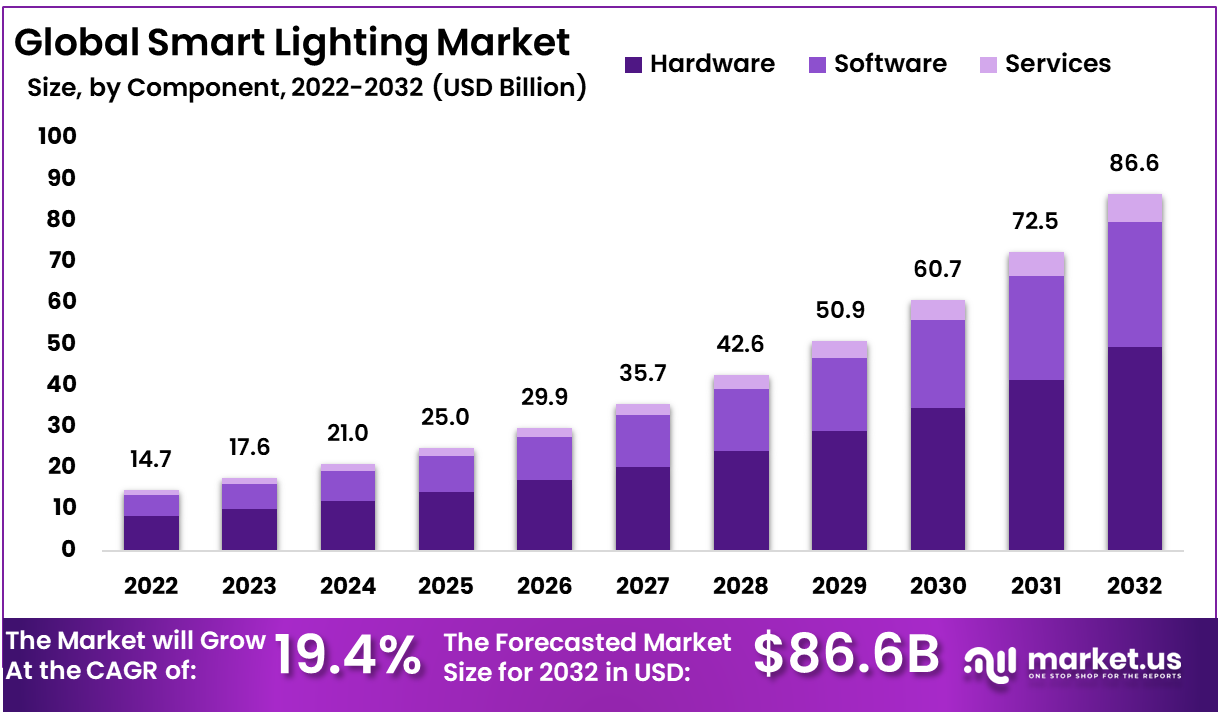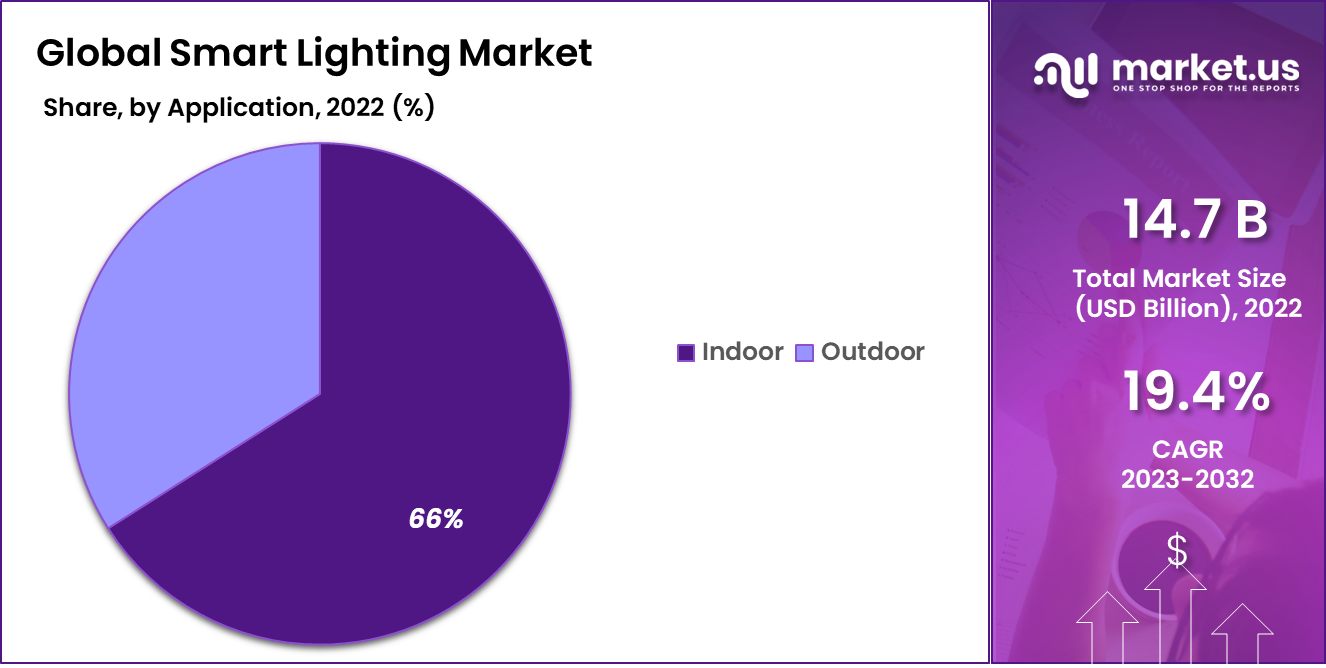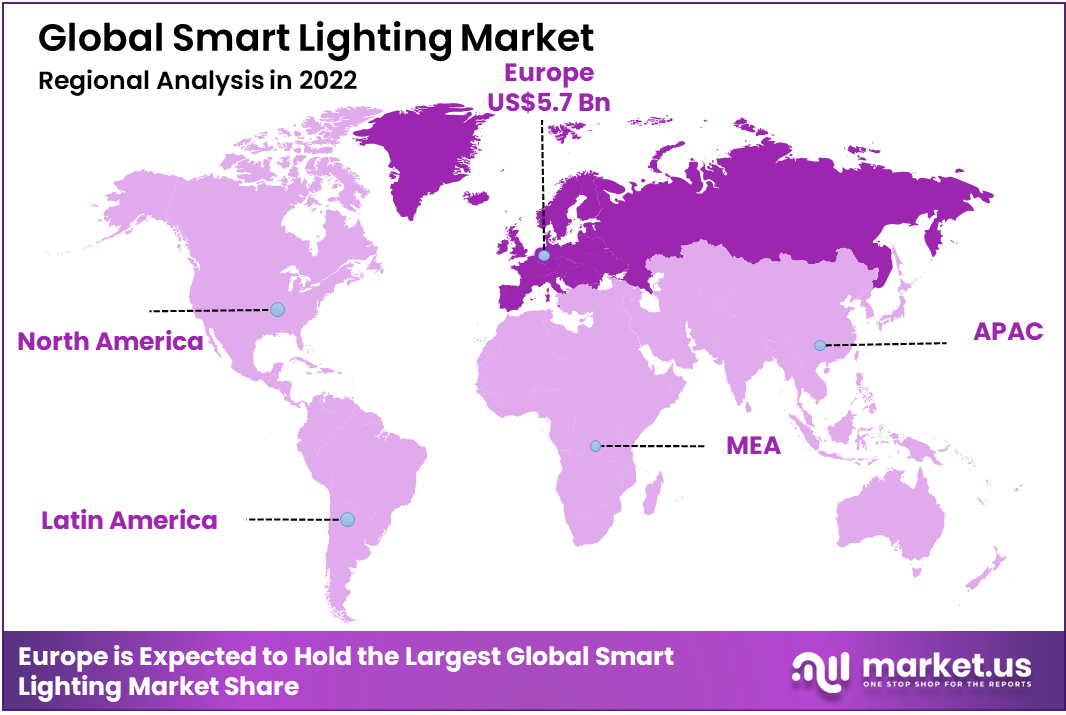Global Smart Lighting Market Size, By Component (Hardware, Software, and Services), By Connectivity (Wireless, Wired), By Installation Type (New Installation, Retrofit Installation), By Application, By Distribution Channel, By Region and Companies - Industry Segment Outlook, Market Assessment, Competition Scenario, Trends, and Forecast 2023-2032
- Published date: Sep 2023
- Report ID: 51894
- Number of Pages: 253
- Format:
- keyboard_arrow_up
Quick Navigation
- Report Overview
- Key Takeaways:
- Driving Factors
- Restraining Factors
- Growth Opportunities
- Latest Trends
- Component Analysis
- Connectivity Analysis
- Installation Type Analysis
- Application Analysis
- Distribution Channel Analysis
- Global Smart Lighting Market Segments Includes:
- Geopolitics and Recession Impact Analysis
- Regional Analysis
- Market Share & Key Players Analysis
- Report Scope:
Report Overview
The Global Smart Lighting Market size is expected to be worth around USD 86.60 Billion by 2032 from USD 14.7 Billion in 2022, growing at a CAGR of 19.40% during the forecast period from 2023 to 2032.
Introduction
The smart lighting market has revolutionized the way we illuminate and control our spaces. This innovative technology goes beyond traditional lighting by offering intelligent, energy-efficient solutions that can be remotely managed and customized. Smart lighting systems use sensors, connectivity, and automation to adjust brightness, color, and ambiance based on user preferences as well as environmental conditions.
With the rising focus on energy conservation and the Internet of Things, the smart lighting market has witnessed rapid growth. It not only enhances convenience but also contributes to significant energy savings, making it a key player in the ever-evolving landscape of smart technology for homes, offices, and cities.

Actual Numbers Might Vary in the Final Report
Key Takeaways:
- In 2022, the global smart lighting market was valued at US$ 14.7 Billion.
- By component, the hardware held a major market share of 57% in 2022.
- By connectivity, wireless held a major market share of 68%.
- By installation Type, the global smart lighting market is segmented into new installation and retrofit installation.
- By application, the indoor held a major market share of 66%.
- By distribution channel, the online platform segment held the largest share of the market.
- In 2022, Europe dominated the market with the highest revenue share of 39%.
- One of the most significant driving forces in the smart lighting market is energy efficiency and sustainability.
- Key players include Signify N.V., Osram GmbH., Acuity Brands Inc., and others.
Driving Factors
Energy Efficiency & Sustainability and Enhanced User Experience
Smart lighting systems are engineered to save energy through various features like motion sensors that activate lights only when needed, dimming capabilities to adjust brightness according to requirements, and daylight harvesting, which optimizes natural light usage.
This heightened energy efficiency resonates with environmentally aware consumers and businesses aiming to minimize their carbon footprint and cut down on electricity expenses. This aligns with global sustainability objectives, making smart lighting an attractive choice for those prioritizing energy conservation and cost reduction.
Smart lighting empowers users to tailor their lighting environment to their specific desires, offering flexibility in adjusting brightness, color temperature, and ambiance. This level of customization fosters an enriched user experience, where individuals can create lighting settings that suit their mood, task, or occasion. In smart homes and offices, this adaptability enhances comfort and productivity, making smart lighting a favored choice for those seeking personalized and responsive illumination solutions.
Restraining Factors
Complex Installation and Limited Awareness
The installation of smart lighting systems can be challenging for many users due to its technical complexity. Setting up these systems often involves configuring devices, connecting them to a network, and sometimes even rewiring existing fixtures. This complexity can be intimidating for residential users who may lack technical expertise, leading to higher installation costs if professional assistance is required. As a result, the perceived difficulty of installation can deter some individuals from adopting smart lighting technology in their homes, slowing its overall adoption.
The market features a wide range of smart lighting products from different manufacturers. Interoperability issues among various devices and platforms can create confusion for consumers and limit the seamless integration of smart lighting into broader smart home ecosystems. The lack of awareness and education about smart lighting systems can act as a significant barrier to their adoption.
Many potential users may not be familiar with the advantages and functionalities that smart lighting offers, such as energy savings, convenience, and customization. Without adequate information and understanding, consumers may be hesitant to invest in these technologies. Raising awareness and providing education about the benefits and ease of use of smart lighting can help overcome this obstacle and drive greater adoption.
Growth Opportunities
IoT Integration and Government Initiatives.
The Internet of Things integration in smart lighting systems enables seamless connectivity with other smart devices and systems, such as sensors, thermostats, and security systems. This interconnectedness creates opportunities for smart homes, smart buildings, and smart cities, where lighting can respond to occupancy, weather conditions, and user preferences.
The commercial and industrial sectors represent significant growth opportunities for smart lighting. These sectors can benefit from energy savings, improved lighting quality, and data analytics capabilities. Smart lighting can be used for smart warehouses, retail stores, office buildings, and manufacturing facilities.
Supportive government policies and incentives promoting energy-efficient lighting solutions can boost the adoption of smart lighting in public infrastructure and government buildings. Initiatives aimed at reducing carbon emissions and energy consumption drive the implementation of energy-efficient lighting technologies.
Latest Trends
Human-Centric Lighting: Human-centric lighting, which adjusts light intensity and color temperature based on the time of day to mimic natural sunlight, gained traction. This trend was particularly prevalent in commercial and healthcare settings, where it was believed to enhance well-being and productivity.
Energy Efficiency: Energy-efficient smart lighting solutions were in the highest demand, driven by sustainability goals and energy cost savings. LED technology continued to dominate the market owing to its energy efficiency and long lifespan.
Advanced Controls: Smart lighting systems incorporate more advanced control features like motion sensors, occupancy sensors, and daylight harvesting. These controls helped optimize lighting usage, reduce energy consumption, and enhance user convenience.
Outdoor Smart Lighting: The adoption of smart lighting extended beyond indoor spaces to outdoor areas, including street lighting, landscape lighting, and smart city projects. These solutions offered energy savings and improved safety.
Component Analysis
The Hardware Segment Dominates the Global Smart Lighting Market
Based on components, the global smart lighting market is segmented into hardware, software, and services. The hardware segment dominated the market with the largest market share of 57% in 2022.
Firstly, hardware components are the tangible and foundational elements of any smart lighting system. These components include smart bulbs, fixtures, switches, sensors, and control devices that form the backbone of a connected lighting infrastructure. As such, they serve as the primary interface between users and the smart lighting ecosystem.
Secondly, hardware components are the most visible and accessible elements for consumers and businesses. They are relatively easy to install and integrate into existing lighting setups, making the adoption of smart lighting systems more convenient and user-friendly. This simplicity has significantly contributed to the widespread acceptance and penetration of smart lighting solutions among residential, commercial, and industrial users.
Thirdly, hardware components encompass a wide variety of products catering to diverse needs and preferences. Manufacturers have introduced an extensive range of smart lighting hardware options, including energy-efficient LED bulbs, color-changing smart bulbs, motion sensors, dimmer switches, and advanced lighting fixtures. This diversity allows users to tailor their lighting systems to their specific requirements, further driving demand.
Connectivity Analysis
The wireless Segment Dominates the Global Smart Lighting Market
Based on connectivity, the global smart lighting market is segmented into wireless and wired. The wireless segment has convincingly emerged as the dominant category in the global smart lighting market due to a combination of practical advantages and consumer preferences.
Firstly, wireless connectivity offers unparalleled flexibility and ease of installation. Unlike wired systems, which require complex and costly installation processes involving cables and conduits, wireless smart lighting systems can be set up quickly and without major structural modifications. This simplicity makes wireless solutions highly accessible to both residential and commercial users.
Secondly, wireless smart lighting provides seamless scalability. Users can easily add or relocate smart lighting devices without the constraints of physical wiring. This adaptability is especially crucial in rapidly evolving environments such as commercial spaces, where lighting needs may change frequently due to office reconfigurations or expansions.
Installation Type Analysis
Based on installation type, the global smart lighting market is segmented into new installation and retrofit installation. New installation involves integrating smart lighting systems during the initial construction or renovation of buildings, making it an integral part of the design. In contrast, retrofit installation involves upgrading existing lighting systems with smart technology, enhancing energy efficiency and control without the need for major structural changes.
While new installations offer seamless integration, retrofit installations are cost-effective solutions for upgrading older infrastructure, catering to a wide range of applications, and ensuring sustainability in lighting solutions. Both installation types cater to diverse consumer needs and preferences in the evolving smart lighting market.
Application Analysis
The Indoor Segment Dominates the Global Smart Lighting Market
Based on application, the global smart lighting market is segmented into indoor, and outdoor. The indoor segment dominated the market with the largest market share of 66% in 2022. Firstly, indoor lighting plays a pivotal role in our daily lives, influencing the ambiance, comfort, and functionality of residential, commercial, and industrial spaces. As a result, there is a higher demand for innovative lighting solutions that enhance the indoor environment, making it more appealing and energy-efficient.
Secondly, the versatility of indoor smart lighting applications is vast. Consumers can employ smart lighting systems for a wide range of indoor settings, including homes, offices, retail spaces, healthcare facilities, and hospitality venues. This versatility ensures a broad consumer base and sustained market demand.
Furthermore, the integration of indoor smart lighting with home automation systems has gained significant traction. Smart bulbs, fixtures, and lighting controls that can be customized and controlled remotely via smartphones and voice assistants have become immensely popular among homeowners, contributing to the indoor segment’s dominance.
Distribution Channel Analysis
Based on the distribution channel, the global smart lighting market is segmented into online platforms and offline stores. The online platform segment has gained prominence and is steadily dominating the smart lighting market due to several compelling reasons. Firstly, the convenience factor plays a significant role, as consumers can browse, compare, and purchase a wide range of smart lighting products from the comfort of their homes or workplaces. This convenience is especially appealing to busy individuals who may not have the time to visit physical stores.
Secondly, the online channel offers an extensive product selection, enabling consumers to explore various brands, models, and features with ease. This variety is crucial in the smart lighting market, where consumers often have specific preferences and requirements, such as compatibility with their existing smart home ecosystems.
While the online platform dominates, offline stores still hold significance in the smart lighting market. Physical retail outlets, such as home improvement stores, lighting showrooms, and electronics retailers, offer certain advantages. Customers can experience the products in person, assessing factors like brightness, color temperature, and design.

Global Smart Lighting Market Segments Includes:
By Component
- Hardware
- Software
- Services
By Connectivity
- Wireless
- Wired
By Installation Type
- New Installation
- Retrofit Installation
By Application
- Indoor
- Outdoor
By Distribution Channel
- Online Platform
- Offline Stores
Geopolitics and Recession Impact Analysis
- Trade Relations and Tariffs: Geopolitical tensions between major economies, such as the United States, China, and the European Union, can impact the supply chain of smart lighting components. Tariffs and trade restrictions can lead to increased production costs, potentially affecting product pricing and market competitiveness.
- Regulatory Standards: Geopolitical factors can influence regulatory standards related to energy efficiency, data privacy, and cybersecurity. Varied regulations across regions may necessitate product modifications and compliance efforts, affecting product development timelines and costs.
- Consumer Spending: Economic recessions can lead to reduced consumer spending on non-essential items, including smart lighting. Consumers may delay or scale back on home improvement projects, affecting the demand for smart lighting products.
- Construction Industry: The construction industry plays a vital role in the adoption of smart lighting, as new construction and renovation projects often incorporate these technologies. During recessions, the construction sector may experience slowdowns, impacting the smart lighting market.
Regional Analysis
Europe Dominates the Global Smart Lighting Market
Europe is the largest market for smart lighting market, accounting for the largest share of 39% in the global market. Europe has asserted dominance in the global smart lighting market due to a combination of factors that collectively position the region as a leader in this industry.
Firstly, Europe places a significant emphasis on sustainability and energy efficiency, driven by stringent regulations and environmental awareness. Smart lighting, with its energy-saving capabilities, aligns perfectly with these priorities, making it a preferred choice for residential, commercial, and industrial applications.
Secondly, Europe boasts a robust infrastructure and advanced technological ecosystem that fosters innovation. This innovation culture has given rise to numerous European companies that specialize in smart lighting solutions. These companies continually push the boundaries of technology, creating cutting-edge products that cater to a diverse range of needs and preferences.
Furthermore, Europe has a strong commitment to smart city initiatives, where intelligent lighting systems play a pivotal role in enhancing urban living. This emphasis on urban development and infrastructure modernization has driven significant investments in smart lighting projects across European cities, further fuelling market growth.

Key Regions and Countries Covered in this Report:
- North America
- The US
- Canada
- Europe
- Germany
- France
- The UK
- Italy
- Spain
- Russia & CIS
- Rest of Europe
- APAC
- China
- Japan
- South Korea
- India
- ASIAN
- Rest of APAC
- Latin America
- Brazil
- Mexico
- Rest of Latin America
- Middle East & Africa
- GCC
- South Africa
- United Arab Emirates
- Rest of the Middle East & Africa
Analyzing the market share & key players in the global smart lighting market supplies insights into the competitive landscape and major contributors to the industry.
Signify is a prominent player in the global smart lighting market, offering a vast range of smart lighting solutions under brands such as Philips Hue.
Market Key Players:
- Signify N.V.
- Osram GmbH
- General Electric Company
- Acuity Brands Inc.
- Schneider Electric SE
- Lutron Electronics Co. Inc.
- Cree Inc.
- Eaton Corporation plc
- Zumtobel Group AG
- Hubbell Incorporated
- Legrand S.A.
- Honeywell International Inc.
- Other Key Players
Recent Developments
- Osram has launched smart lighting products with advanced features catering to different applications.
- GE Lighting has concentrated on enhancing its smart lighting portfolio, with a focus on IoT integration and voice control compatibility.
Report Scope:
Report Features Description Market Value (2022) US$ 14.7 Billion Forecast Revenue (2032) US$ 86.6 Billion CAGR (2023-2032) 19.4 % Base Year for Estimation 2022 Historic Period 2016-2022 Forecast Period 2023-2032 Report Coverage Revenue Forecast, Market Dynamics, COVID-19 Impact, Competitive Landscape, Recent Developments Segments Covered By Component-Hardware, Software, and Services; By Connectivity-Wireless, Wired; By Installation Type-New Installation, Retrofit Installation; By Application- Indoor, Outdoor; By Distribution Channel-Online Platform, Offline Stores. Regional Analysis North America: The US and Canada; Europe: Germany, France, The UK, Italy, Spain, Russia & CIS, and the Rest of Europe; APAC: China, Japan, South Korea, India, ASEAN, and the Rest of APAC; Latin America: Brazil, Mexico, and Rest of Latin America; Middle East & Africa: GCC, South Africa, United Arab Emirates, and Rest of Middle East & Africa. Competitive Landscape Signify N.V., Osram GmbH, General Electric Company, Acuity Brands Inc., Schneider Electric SE, Lutron Electronics Co. Inc., Cree Inc., Eaton Corporation plc, Zumtobel Group AG, Hubbell Incorporated, Legrand S.A., Honeywell International Inc., Other Key Players. Customization Scope Customization for segments, region/country-level will be provided. Moreover, additional customization can be done based on the requirements. Purchase Options We have three licenses to opt for: Single User License, Multi-User license (Up to 5 Users), Corporate Use License (Unlimited User and Printable PDF) Frequently Asked Questions (FAQ)
How big smart lighting market?The global smart lighting market size was valued at USD 12.9 billion in 2021 and is projected to reach USD 90.71 billion by 2032, at a CAGR of 19.4% during the forecast period.
Which is the potential market for smart lighting in terms of the region?Asia Pacific (APAC) is the largest market for smart lighting. APAC, being one of the fastest-growing markets for technology and lighting solutions, provides attractive opportunities for players offering smart lighting; as a result, many companies are expanding their footprint in this region. China, India, and Japan are among the key digital hubs in APAC that occupy the maximum share of the market of the region. The booming commercial and industrial spaces would further fuel the adoption of smart lighting in APAC. Furthermore, growth in end-use sectors and mounting investments from government bodies are also favoring the growth of the smart lighting market in the region.
Which are the leading players in the smart lighting business?Major companies across the industry comprise Hubbell Incorporated, Bridgelux Inc., Legrand SA, Cree, Inc., Schneider Electric Software LLC, Lutron Electronics Co., Inc., Silver Spring Networks, and others.
Which are the major players in the smart lighting market?Major players in the smart lighting market are Acuity Brands Inc., Honeywell International Inc, Zumtobel Group AG, Philips Hue, and others.

- Signify N.V.
- Osram GmbH
- General Electric Company
- Acuity Brands Inc.
- Schneider Electric SE. Company Profile
- Lutron Electronics Co. Inc.
- Cree Inc.
- Eaton Corporation plc
- Zumtobel Group AG
- Hubbell Incorporated
- Legrand S.A.
- Honeywell International Inc.
- Other Key Players
- settingsSettings
Our Clients
| Single User $4,599 $3,499 USD / per unit save 24% | Multi User $5,999 $4,299 USD / per unit save 28% | Corporate User $7,299 $4,999 USD / per unit save 32% | |
|---|---|---|---|
| e-Access | |||
| Report Library Access | |||
| Data Set (Excel) | |||
| Company Profile Library Access | |||
| Interactive Dashboard | |||
| Free Custumization | No | up to 10 hrs work | up to 30 hrs work |
| Accessibility | 1 User | 2-5 User | Unlimited |
| Analyst Support | up to 20 hrs | up to 40 hrs | up to 50 hrs |
| Benefit | Up to 20% off on next purchase | Up to 25% off on next purchase | Up to 30% off on next purchase |
| Buy Now ($ 3,499) | Buy Now ($ 4,299) | Buy Now ($ 4,999) |












